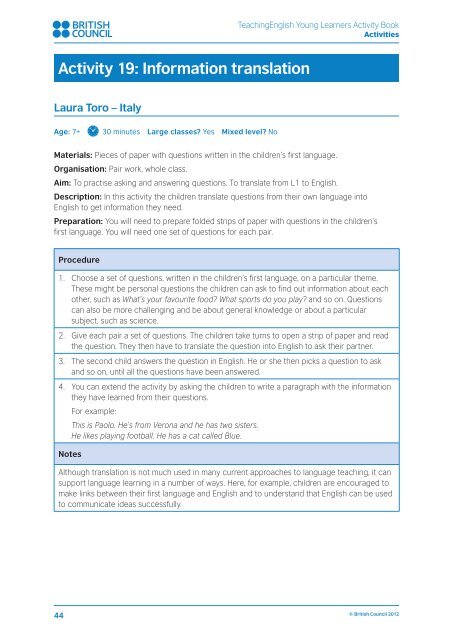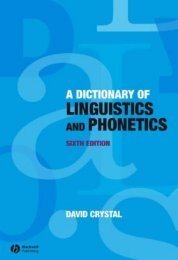url?sa=t&source=web&cd=3&ved=0CC0QFjAC&url=http://www.teachingenglish.org.uk/sites/teacheng/files/B369-Young-Learners-Activity-Book_v10
url?sa=t&source=web&cd=3&ved=0CC0QFjAC&url=http://www.teachingenglish.org.uk/sites/teacheng/files/B369-Young-Learners-Activity-Book_v10
url?sa=t&source=web&cd=3&ved=0CC0QFjAC&url=http://www.teachingenglish.org.uk/sites/teacheng/files/B369-Young-Learners-Activity-Book_v10
Create successful ePaper yourself
Turn your PDF publications into a flip-book with our unique Google optimized e-Paper software.
TeachingEnglish <strong>Young</strong> <strong>Learners</strong> <strong>Activity</strong> <strong>Book</strong><br />
Activities<br />
<strong>Activity</strong> 19: Information translation<br />
Laura Toro – Italy<br />
Age: 7+<br />
30 minutes Large classes? Yes Mixed level? No<br />
Materials: Pieces of paper with questions written in the children’s first language.<br />
Organisation: Pair work, whole class.<br />
Aim: To practise asking and answering questions. To translate from L1 to English.<br />
Description: In this activity the children translate questions from their own language into<br />
English to get information they need.<br />
Preparation: You will need to prepare folded strips of paper with questions in the children’s<br />
first language. You will need one set of questions for each pair.<br />
Procedure<br />
1. Choose a set of questions, written in the children’s first language, on a particular theme.<br />
These might be personal questions the children can ask to find out information about each<br />
other, such as What’s your favourite food? What sports do you play? and so on. Questions<br />
can also be more challenging and be about general knowledge or about a particular<br />
subject, such as science.<br />
2. Give each pair a set of questions. The children take turns to open a strip of paper and read<br />
the question. They then have to translate the question into English to ask their partner.<br />
3. The second child answers the question in English. He or she then picks a question to ask<br />
and so on, until all the questions have been answered.<br />
4. You can extend the activity by asking the children to write a paragraph with the information<br />
they have learned from their questions.<br />
For example:<br />
This is Paolo. He’s from Verona and he has two sisters.<br />
He likes playing football. He has a cat called Blue.<br />
Notes<br />
Although translation is not much used in many current approaches to language teaching, it can<br />
support language learning in a number of ways. Here, for example, children are encouraged to<br />
make links between their first language and English and to understand that English can be used<br />
to communicate ideas successfully.<br />
44<br />
© British Council 2012





